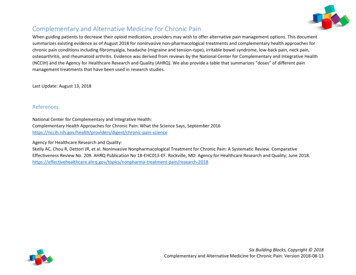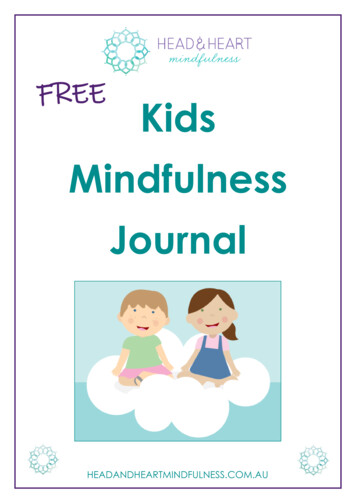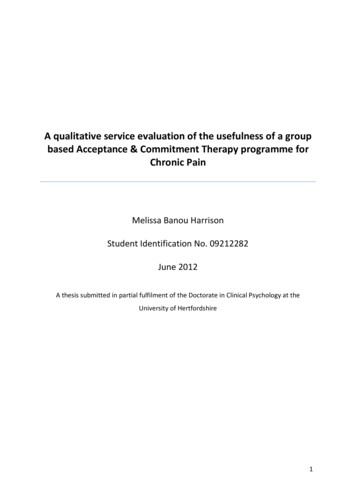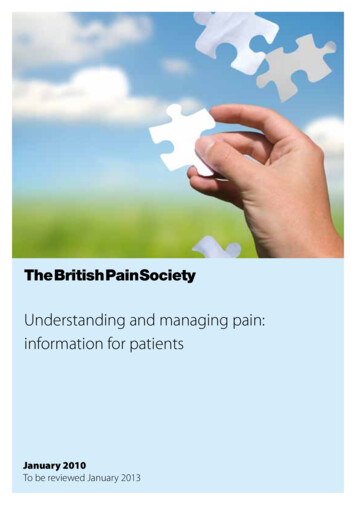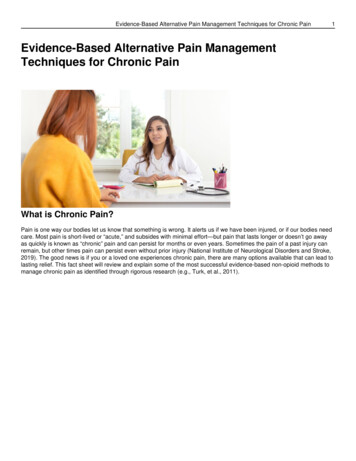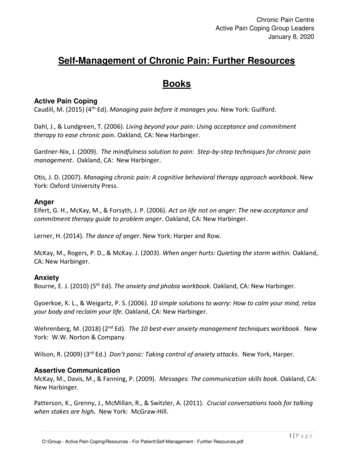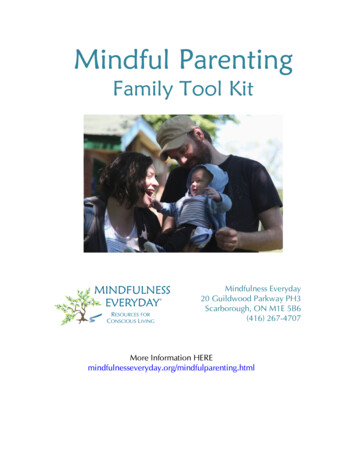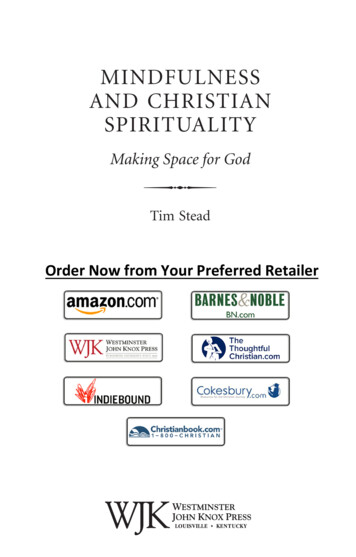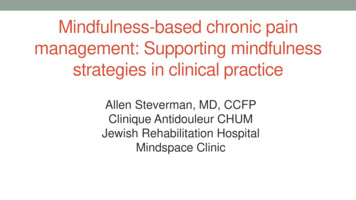
Transcription
Mindfulness-based chronic painmanagement: Supporting mindfulnessstrategies in clinical practiceAllen Steverman, MD, CCFPClinique Antidouleur CHUMJewish Rehabilitation HospitalMindspace Clinic
Disclosure Advisory Board: Purdue Dec 2016, Paladin Dec 2016, KnightTherapeutic May 2017
Objectives As a result of attending this session, participants will beable to: Better understand the mind-body connection andwhere it breaks down in chronic pain Explore the content of a mindfulness basedtrauma-informed approach to pain management Appreciate how to support mindfulness strategiesin clinical practice
The Mind/Body Connection Suffering caused by chronic pain comes from thecombination of the pain sensation and what itmeans to the sufferer - how it is interpreted Pain is an experience - not just a sensation Physical pain and mental pain often inseparable The experience of pain always has both a physicaland psycho-emotional component
The Mind/Body Connection Chronic pain : Mind-Body Connection ”windup” Pain is not just a ”body” problem, it is a whole-systems problem (Jon Kabat-Zinn) Mind plays an important role in physical illness This is certainly not to say that pain is ”all in theirheads”
Why Mindfulness for chronic pain? With mindfulness, learn to uncouple the somatic sensationsfrom thoughts and emotions Invitation to turn in towards the pain – tune in to the sensations Unpleasant sensation still there, but the knowing of unpleasantsensation is actually liberated from the suffering Goal is not to change the content of one’s experience, butrather altering the way in which it is experienced Befriend the way things are - Do I want it ? No. But is it erodingthe quality of my life? Not like before (Kabat-Zinn)
Why Mindfulness for chronic pain? What Doc? You want me to bring attention andawareness to my pain ?!? Internal or Interoceptive awareness of what’s going on in thebody: Initial increase in pain, then over time reduced When we pay attention, usual reflex is to take consciousnessaway from pain – stress response – but letting it go there andstay there seems to play a role in healing process When you go there, you go there with compassion
Mindfulness based chronic pain managementMBCPMTM program – Dr Jackie Gardner-Nix Based on MBSR (Mindfulness based stress reduction) – JonKabat-Zinn Elements in common with MBCT (based on traditional CBT) –Noticing automatic reactions to various challenges Elements from ACT (Acceptance and Commitment Therapy) –prolonged exposure to events that may be causingpsychological distress in order to cultivate acceptance andreduce avoidance MBCPMTM: Program more customized to the needs of thosedealing with chronic pain
MBCPMTM program Weekly education and discussion Factors that influence pain Through the lens of mindfulness Meditation practice Not a replacement for usual treatments
Biopsychosocial n-definitions/
MBCPMTM program Insights into why pain and suffering have becomeestablished Giving patients tools to manage the narratives of their ownlives in order to help the healing process Help understand how physical, psychological andemotional aspects of pain interact Reduce reactivity and Increase resilience Improve overall health, improve function and decreasesuffering
MBCPMTM program Particular attention to being trauma-informed and trauma-sensitive Meditation training – more gentle pace 12-13 week (vs 8 week) Shorter meditations Gradually introduced weekly Breath focused, movement based, visualizations, guided imagery Weekly discussion and support for meditation related challenges
Course delivered in group Get a chance to be with others facing similarchallenges Feeling understood Opportunities to share (smaller groups, dyads) Examining damaged lives Figure out what can be done together Understanding / exploring the suffering of chronic pain
3 Modules of MBCPMTM programLearning about mindfulness and meditationpractice – Module 1 Introduction to Mindfulness The Mind-Body connection and Pain Why does the body break down Negative emotional states and Acceptance Stress and Pain
3 Modules of MBCPMTM programSelf Care and Compassion – Module 2 Exploring the relationship between eating and pain Exploring the relationship between exercise and pain Importance of Sleep and Pain Understanding attitudes to the damaged self Reversal of “neglect" of painful part of body (Body Scanmeditation)
3 Modules of MBCPMTM programWorking on Behaviours and Self Awareness inRelationships with Others and with Self – Module 3 People stress and Pain Response to stress and conflict Creative work in pain management Mindfulness practice beyond the program
3 Modules of MBCPMTM program Throughout the program, different meditationsintroduced weekly Meditations connect with themes discussed andsupport mindfulness practice Mindfulness is experiential Importance of regular meditation practice, if possibleevery day
Learning about mindfulness – Module 1Core concepts of Mindfulness Meditation Mindfulness is the awareness that arises through payingattention, on purpose, in the present moment, nonjudgementally (Jon Kabat-Zinn) Maintaining a moment-by-moment awareness of our thoughts,feelings, bodily sensations, and surrounding environmentwithout judging them Giving equal attention and value to what is happening in eachmoment of your life Seeing that every moment is transient – including pain in itsquality and intensity
Core concepts of Mindfulness Meditation Being mindful - Not just paying attention to positiveexperiences, but also to the neutral and negative ones Avoidance of feeling more difficult emotions can prolong theirpower over health When we resist what is, we add another layer to suffering When we can find acceptance, our relationship with illnessbegins to change Awareness allows a space between triggers and reactions Responding rather than reacting
Principles/Attitudes Non-judging Beginner's mind Patience Trust Non-Striving Acceptance Letting go
Mindfulness and Meditation Meditation: Setting aside a specific period of timein which we practice focused awareness of whatwe sense and experience in the present moment Practicing daily allows the mind to practiceentering a state of lowered arousal and to practicebeing present without evaluating what is noticed Sympathetic activity may decrease andparasympathetic activity increase
Mindfulness and Meditation Meditation Relaxation Mind focusing vs Mind wandering Not mind emptying, not thought suppression It is focused, non judgmental awareness in the presentmoment Repeatedly noticing “thinking" arising and returning nonjudgmentally, gently, to a bare, focused, awareness of thepresent Mind will wander – Bring it back No good meditator or bad meditator Not Positive thinking
Mindfulness and Meditation Mindfulness: Moment-to-moment non-judgmental awareness,being fully present with what is happening right now Meditation is the tool we use to cultivate mindfulness Formal practice: meditation Informal practice: mindfulness in everyday moments Being more present, less reactive in daily life
Mind-Body Connection Mind and body in constant communication Sending messages back and forth - chemical reactions Imbalances in the chemistry / neurotransmitters malfunction Imbalances influenced by poor habits including diet,physical activity, but also emotions and thoughts Can attempt to restore balance with medication Can also restore balance by changing thought processes Treatment of anxiety, depression, pain
Mind-Body Connection Physical condition of our bodies can influence thoughts and feelings ofourselves Thoughts and feelings can influence physical condition of our bodies Negative thoughts can worsen pain conditions This is not to say the pain is just in the mind:The pain is real Thoughts will actually change what’s going on in the body With emotional reactivity Body clenching Negative self-statements can increase sensitivity to pain Changing thoughts and feelings can affect healing process
Why does the body break down? Illness and healing affected by genetics and lifeexperiences How you react to challenging events/stress Impact of parental nurturing – managing stress Not a blame game – but opportunity for insight
Why does the body break down? A lot of negative stress, especially in childhood negative healthimpacts Chronic stress long term health impacts Teaching how to respond to stress is key Epigenetics Role of physical stressors AND emotional stressors on How our health is affected How disease-related genes may be expressed How healing is affected How we relate to pain and experience it
But Doc, my pain is not emotional, it’s in my BODYLarge international study – The Lancet 2004Risk factors for Acute Myocardial InfarctionAnger, Depression, Anxiety, Lack of social support, Chronic stress ︎ ︎ ︎ ︎Contributed to likelihood of having an Acute MI on par with Physical stressors of smoking, obesity, HTN, High cholesterolSo, ”physical illness” highly influenced by ”emotional factors”
Persistent negative emotional states Persistent negative emotions (helplessness,hopelessness, anger, frustration) can keep you sick Antibiotics can’t work well to fight infection ifimmune system compromised Pain medications don’t work well if emotional statepersistently negative
Persistent negative emotional states Mindfulness as a complement to usual approaches –increasing their effectiveness With Mindfulness, become more aware of: Root of emotions The way your thoughts work Why the body and mind have been functioning the way theyhave Increased awareness of mind-body connection Deal withchronic pain differently
Acceptance Acceptance can influence ability to manage pain Springboard to adapting and adaptations Acceptance not static – fluctuates Acceptance Resignation Evidence that improves emotional and physical function,reduces medication use, and increases likelihood of working Level of pain not predictive of level of functioning Movement and walking meditations
Stress Manifestations of Stress in the Body/Mind – Groupexercise Realization of the various ways stress can influence thebody Discussion of the physiology of stress Biology of stress – fight or flight Parenting and stress Becoming more mindful changes the way the mind reactsto stress, changing the pain experience
“Stress can be banked” Healing affected by current stress Healing also affected by past stress Many chronic pain sufferers with severe childhood stressors Study (Schofferman and associates 1993) – Outcome post spinal surgery History of physical, emotional, or sexual abuse? Parent or caregiver with alcohol or drug abuse? Parent or caregiver left the home or died? If none of these factors – 95% individuals did well after surgery anddid not require as much pain relief If 3 or more of the factors - 15% individuals did well after surgery
Trauma and pain Life trauma and pain Challenging pasts Some people don’t heal after an injury High rates of trauma in people with chronic pain Fibromyalgia, arthritis, chronic low-back pain, chronicheadache, migraine, chronic pelvic pain Age factor: the younger, the more likely to heal OK despitepast life experience; as enter middle age the body isn’t soforgiving if past experiences were experienced with suffering
Trauma and pain Chronic pain – central sensitization Relationship between trauma and pain – via centralsensitization on nervous system that is already reactive? Triggers Note: history of trauma not necessary to develop chronicpain
Trauma The Body Remembers: The Psychophysiology ofTrauma and Trauma Treatment - Babette Rothschild The Body Keeps the Score: Brain, Mind, and Body inthe Healing of Trauma - Bessel Van der Kolk When the body says so: The Cost of Hidden Stress Gabor Maté Trauma-Sensitive Mindfulness: Practices for Safe andTransformative Healing – David Treleaven
Managing stress – increasing resilience Capacity to manage stress influenced by: Genetics Childhood experiences Diet Exercise Sleep Relationships
Self-Care and Compassion – Module 2The relationship between food, eating and pain Through the lens of mindfulness Poor eating habits – a physical stressor Affects mood and pain Sometimes we eat because we are hungry Food habits and choices – increasing awareness Exploration of food and pain – becoming aware of body andmind’s responses to food
The relationship between exercise and pain The benefits of movement (exercise) Endorphins? Endocannabinoids? Kinesiophobia Regular movement bolsters emotional resilience, affectsperception of pain Mindful movement meditation Finding the right balance - pacing Being more mindful - more likely to be aware when limit is reached And more likely to accept the limit without regret
Importance of Sleep and Pain Consequences of impaired sleep on pain Decreased tolerance to pain Education on sleep and sleep stages Sleep apnea Discussion of sleep hygiene Sleep meditation
Understanding attitudes to the damaged selfFurther Meditations Body Scan Meditation Bringing awareness to every part of the body and mind, includingthose in pain Not introduced until mid-program Reconnecting with the parts of the body that have been shunned Acknowledging and Acceptance Loving Kindness Meditation Supports and improves ongoing awareness of the body/mind asa whole
Working on Behaviours and Self-Awarenessin Relationships with Others and with SelfModule 3People Stress and Pain If you are emotionally stressed, it’s harder to heal andcope with pain Pain exacerbation – can be connected to emotional difficultinteraction just as much as physical activity Story of Gillian
Responses to Stress & Conflict Typical responses illustrated by examples from Aikido Doormat response Avoidance response Combative response Blending or Compromise response Help identify which behaviours we use most often And the associated emotions and impact on physical painexperience
Responses to Stress & Conflict With mindfulness: awareness of self in conflict situations Increases ability to respond, rather than react Setting boundaries Mindfulness of body language and tone of voice Managing difficult people
Creative work in pain management Alternative method of expression Opportunity for sharing May help communicate when words not adequate Opportunity for insight Snapshot of present moment experience of pain Springboard to healing and acceptance
Supporting mindfulness strategies in clinicalpractice – Key concepts for the family physician Suffering caused by chronic pain comes from the combinationof the pain sensation and what it means to the sufferer Pain is not just a ”body” problem, it is a whole-system problem Mind-body imbalances influenced by poor habits including diet,physical activity, but also emotions and thoughts Thoughts and feelings can influence physical condition of ourbodies This is not to say the pain is just in the mind: The pain is real
Supporting mindfulness strategies in clinicalpractice – Key concepts for the family physician With mindfulness, learn to uncouple the somaticsensations from thoughts and emotions Becoming more mindful changes the way the mind reactsto stress, changing the pain experience Can help reduce reactivity and increase resilience Acceptance: allows relationship with pain to begin tochange and serves as a springboard to adaptation
Supporting mindfulness strategies in clinicalpractice – Key concepts for the family physician Reinforce self care: fostering awareness of impact ofeating habits, physical activity and sleep on pain Help bring awareness to factors influencing pain beyondphysical triggers including emotional stressors and ourresponses to stress and conflict Particular attention to the possibility of trauma Support regular meditation practice
Conclusion A Mindfulness based chronic pain managementprogram can be a valuable addition to thetreatment chronic pain, complementing moretraditional approaches Potential to decrease pain intensity, improvefunction, and overall reduction in suffering
References Rosengren et al. 2004. Association of psychological risk factors with risk of acute myocardialinfarction in 11119 cases and 13648 controls from 52 countries (the INTERHEART study):Case control study. The Lancet 364 (9438): 953-962 Schofferman J, Anderson D, Hines R, Smith G, Keane G, Clin J Pain. 1993 Dec;9(4):260-5. Childhood psychological trauma and chronic refractory low-back pain
References U of Toronto professional trainings for the Applied Certificate in MBCPM ased-chronic-pain-management-mbcpm-facilitation h#/profile/3501 h#/profile/3502 h#/profile/3503 NeuroNova Centre For Mindful Solutions Inchttps://neuronovacentre.com MBCPMTM Mindspace clinic in Montrealhttp://mindspaceclinic.com/service/mbcpm/
Mindfulness and Meditation Mindfulness: Moment-to-moment non-judgmental awareness, being fully present with what is happening right now Meditation is the tool we use to cultivate mindfulness Formal practice: meditation Informal practice: mindfulness in everyday moments Being more present, less reactive in daily life


